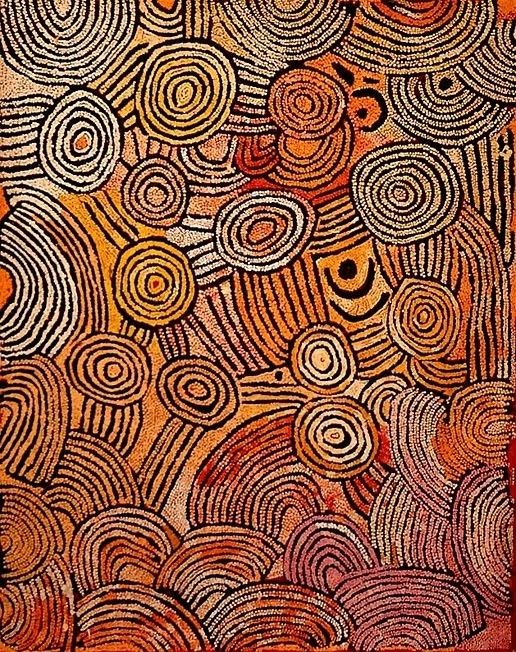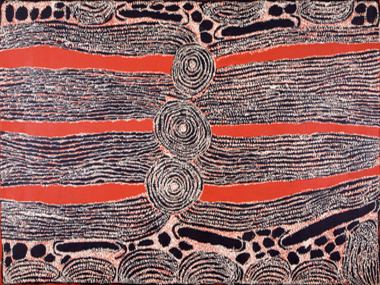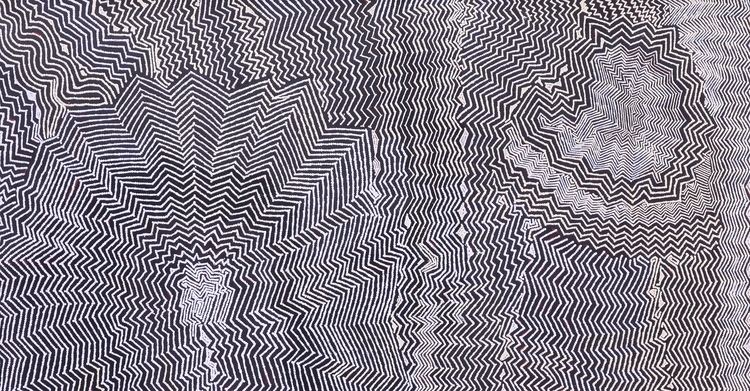 | ||
Papunya Tula, or Papunya Tula Artists Pty Ltd, is an artist cooperative formed in 1972 that is owned and operated by Aboriginal people from the Western Desert of Australia. The group is known for its innovative work with the Western Desert Art Movement, popularly referred to as "dot painting". Credited with bringing Aboriginal art to world attention, its artists inspired many other Australian Aboriginal artists and styles. The company operates today out of Alice Springs and is widely regarded as the premier purveyor of Aboriginal art in Central Australia.
Contents
Background

In the late 1960s, the Australian government moved several different groups living in the Western Desert region to Papunya, 240 km northwest of Alice Springs in the Northern Territory, to remove them from cattle lands and assimilate them into western culture. These displaced groups were primarily Pintupi, Luritja, Walpiri, Arrernte, and Anmatyerre peoples.

In 1971, Geoffrey Bardon, the school teacher at the community, encouraged the children to paint a mural using the traditional style of body and sand ceremonial art. This painting style was used for spiritual purposes, and so had strict protocols for its use. Many symbols depicted personal totems and Dreamings, and others more general Dreamtime creation stories. When some of the elder men saw what the children were doing, they felt the subject matter was more suited to adults. They began creating a mural depicting the Honey Ant Dreaming. Traditionally, Papunya is the epicenter of the Honey Ant Dreaming, where songlines converge. The European-Australian administrators of Papunya later painted over the murals, which the curator Judith Ryan called "an act of cultural vandalism", noting that "[t]he school was de-Aboriginalized and the art no longer allowed to stand tall and defiant as the symbol of a resilient and indomitable people". While visible, the mural proved highly influential, leading other men to create smaller paintings of their Jukurrpa (Ancestral stories), on any available surface, including bits of old masonite, car bonnets, tin cans, and matchboxes. This explosion of artistic activity is generally regarded as the origin of contemporary Indigenous Australian art.

The collective, originally entirely Aboriginal Australian men, formed in 1972. They derived the name tula from a small hill near Papunya, a Honey Ant Dreaming site. A few women, notably Pansy Napangardi, began to paint for the company in the late 1980s. It was not until 1994 that women generally began to participate.

While the collective artists used a style of painting traditional in the sand and for body adornment in ceremonies, most of them had never painted before in Western style – that is, using acrylic paint and a hard surface. As their work gained in popularity, the artists omitted or changed many of the spiritual symbols for public viewing, as the Aboriginal community criticized the artists for revealing "too much of their sacred heritage". According to Ryan:

In the late 1970s and early '80s, after the establishment of the Aboriginal Land Rights Act, many of the people left Papunya for their traditional lands, but the art cooperative persisted and continued to grow. For many years the market and museums virtually ignored their work. A major exception was the Museum and Art Gallery of the Northern Territory (MAGNT) that has the largest collection of just over 220 early works acquired between 1972-76, thanks to the visionary efforts of the MAGNT Director Dr Colin Jack Hinton and Alice Springs gallery owner Pat Hogan. This is still the nation's largest collection of early boards. The National Gallery of Victoria did not acquire any works produced by the collective until 1987, when Judith Ryan convinced the current director to purchase 10 of the works. At the time, the asking price was $100,000, which Ryan described in 2008 as "a steal", given the escalation in value. In 2007, a single painting by Papunya Tula artist Clifford Possum Tjapaltjarri set a record at auction for price commanded for Aboriginal art, bringing £1.03 million (or $2.4 million), more than twice as much as the previous record-holder.
Art Gallery of NSW 2000 Exhibition
In 2000, the Art Gallery of NSW held an exhibition, curated by Hetti Perkins, for the Sydney Olympic Games Arts Festival. The exhibition, entitled Papunya Tula, Genesis and Genius, was the first major retrospective exhibition of the cooperative.
National Museum of Australia 2007–2008 Exhibition
For a period of several months (27 November 2007 to 3 February 2008), the National Museum of Australia exhibited a collection of Papunya paintings from the first few years of the movement. Most of the works displayed in the collection had not been seen before by the general public as most of these paintings were bought by the Aboriginal Arts Board (now defunct) of the 1970s-1980s. The exhibition contains some of the most priceless and earliest works by the first generation, senior Papunya painters. These paintings were previously displayed in government offices and embassies. Curated by Professor Vivien Johnson, the exhibition was significant in introducing the movement's importance to the general audience.
Musée du Quai Branly
Two Papunya artists, Tommy Watson and Ningura Napurrula, are also represented in Paris at the Musée du Quai Branly, dedicated to indigenous art of the world. Napurrula's signature black-and-white motifs appear superimposed on the ceiling of the administration part of the museum's building.
